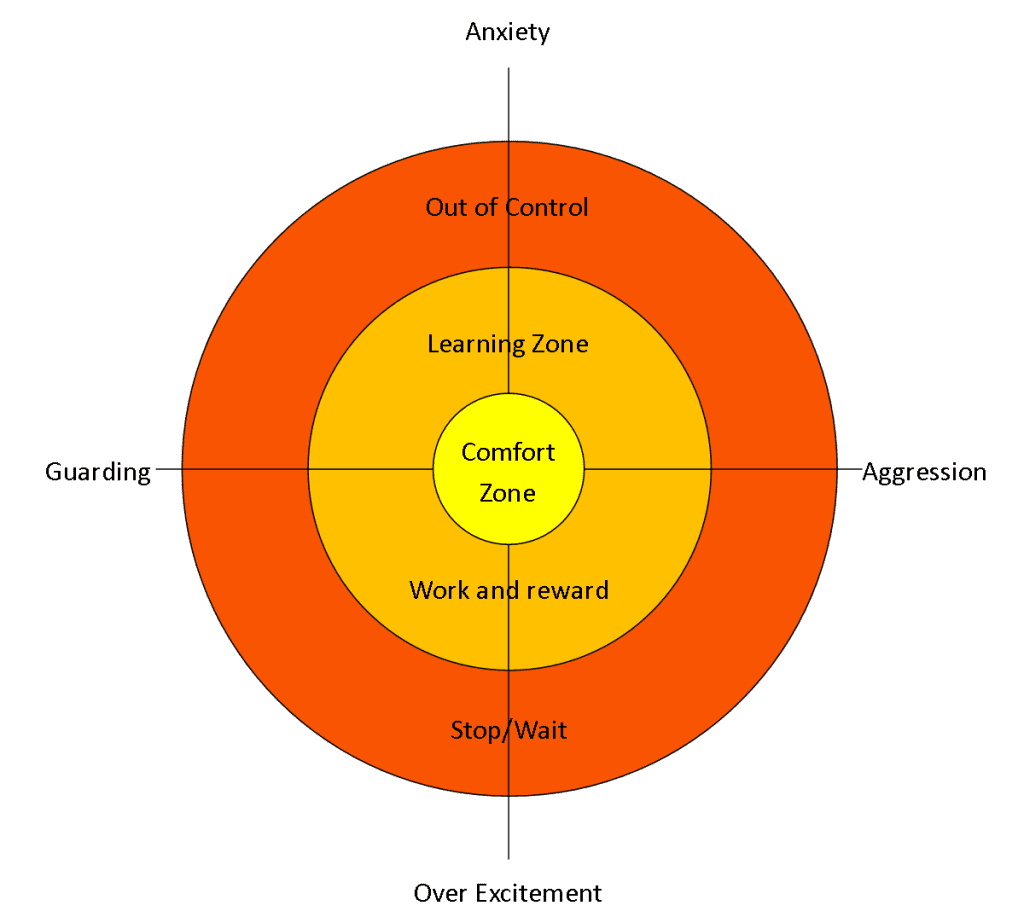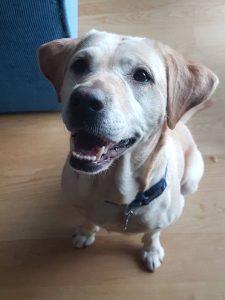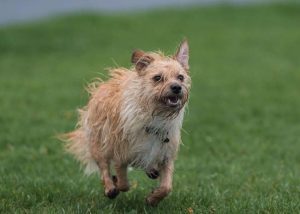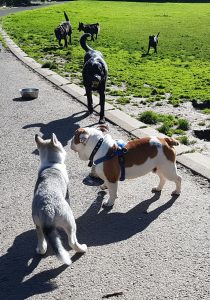Need help with Reactive Dog Behaviour? Join my FREE Facebook support group...
Managing Emotions not Behaviour!
Often training plans focus on changing a specific behaviour, but I think this can be a mistake. A calm dog is rarely a challenging dog, so it makes sense to focus on achieving a calm mind as opposed to chasing your dog about trying to stop them from jumping up, stealing, pulling on the lead, or whatever else they might be doing.
In the diagram, I have divided the phases into three main zones. You could go more specific and create more zones, if you wanted, but I don’t like to over complicate things. So for now we’ll stick with just three. They are the comfort zone, the Learning Zone and the Out of Control Zone. I’ll go into more detail, including describing the dogs state of mind, what their behaviour looks like, and what actions you can take while your dog is in the zone below, but this diagram sums it up quite nicely.

Learn about how the hierarchy of needs can also impact your dogs behaviour!
Comfort Zone
This is the zone we are all aiming for. In this zone your dog is calm and content. They are comfortable in their environment, they are listening to you, and confident performing training they know. This is the most enjoyable zone.
If you aren’t sure, his body will look relaxed and there will be very little, or no visible muscle tension. He will have a soft tail, which might have a bounce or wag to it. His ears will be gentle and his mouth and lips relaxed too. There’s not much for you to do in this zone other than to simply enjoy your dog. You can’t go wrong with treats and love in this zone – lay it on as thick as you like!
Learning Zone
In this zone your dog is more alert, he is out of his comfort zone, but not overly anxious or emotional. He might be figuring out new tasks, looking for mischief, learning about his environment, jumping up at your guests, waiting to get his lead on, riding in the car, listening to you, looking out the window, or trying to please you. Watch out for boredom behaviours in this zone. An active mind with nothing to do will find mischief if you aren’t careful. Separation anxiety starts in this zone as anxious behaviours can be self rewarding.
If you are trying to change your dogs behaviour, this is the zone where you can take action. In this zone you can work with your dog to encourage or discourage behaviours. But, the deeper you get into this zone, the less focussed your dog will become and the less effective your efforts will be. If you can, keep them at the bottom end of the scale, so they are just on the edge of the comfort zone. Do this by making a situation easier to cope with in the future. For example, you could create more distance between you and the situation, making the situation quieter, or slower, or break the stimulus down into smaller steps.
You can take action in this zone, and you can also offer rewards. Just be sure that your dog is doing what you want them to do. If you are trying to encourage your dog to walk to heel on their lead, then don’t let them cut across you to get their treat. They should receive it while they are beside you. Likewise, avoid rewards that undo the work you are doing. For example, don’t give your dog a toy as a reward if you are encouraging calm behaviour!

Out of Control
If you are working on a behaviour problem, it’s quite likely you are familiar with this last zone. When your dog breaches the out of control zone you have lost them. They are laser focused on one thing, and that’s not usually you. Depending on how far they have gone into this zone, they might even be dangerous.
Click to read more about Reactive Behaviour in Dogs
In this zone, they could be barking wildly at another dog, lunging on the lead, crying, or running away from you in the park. They could be guarding the front door, or they could even be completely shut down and withdrawn. Their whole body will be tense, the eyes will be wide, the tail stiff, and they will be moving in an exaggerated way. Some dogs may even accidentally soil or urinate if they get this far. If they have become withdrawn, you may also sense an uncomfortable atmosphere.
If your dog makes it to this zone, you should do nothing other than stay calm and make the situation safer (if needed). Your only job is to hold on tight and wait for them to relax back into the Learning Zone by themselves. In most cases, the more you try to “help” the longer this will take, so try not to get involved.
Shouting will only add emotion to the situation and push your dog further into the zone, dragging them away will encourage your dog to return to the panicked behaviour in the future, trying to encourage them to engage with you will only make them withdraw more and trying to catch a dog that’s jumping all over the place will only be encouraged by the attention.
Putting it into practise
Understanding how these zones work will help you know what your dog is going through, and when and how to intervene. Your rehabilitation plan should focus on keeping your dog in the Learning Zone for the maximum impact.
So often, we try to work with our dogs when they are in the Out of Control Zone as this is when the behaviour is most concentrated, but this will only lead to frustration, and a lack of progress. We also like to monitor the behaviour in the Out of Control Zone for signs of improvement. Instead, watch the Learning Zone as that’s where the most change is happening. One day you’ll realise that you didn’t end up in the Out of Control Zone, and then you’ll know you’ve cracked it.
Get some help putting this all into practise…
For Reactive Dog Behaviour, check out my reactive behaviour live online classes or learn in your own time with the reactive dog behaviour course!
Private Dog Behaviour Consultations are also available in the Dundee area and beyond, or via zoom. If you are looking for 1-1 advice and support while you work with your dog, then please get in touch!


